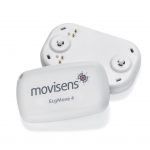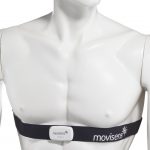HRV-Monitoring
The recent popularity of consumer grade ECG monitors allows individuals to track and record their HRV with varying degrees of accuracy. However, the particular demands of research require a higher standard of than many of these devices can offer.
If you’re a researcher wanting to incorporate HRV analysis in to your work, you’ll profit from our many years of experience helping researchers in this nascent field. We have the tools and skills necessary to help find or develop a solution for your project.
Recommendations for HRV-Monitoring
Stress measurement in everyday life
To obtain an accurate measurement of HRV, you need a clear and accurate recording of the R-peaks in the Ecg signal. The variation of the time interval between these R-peaks gives us our HRV value, so the accuracy of R-peak detection affects the accuracy of the HRV value. movisens recommends a sampling rate of 1024Hz to provide enough information for accurate R-peak detection.
Our EcgMove 4 offers such a high signal quality and records a complete ECG signal with 1024 Hz. With this portable measuring instrument movisens offers an ambulatory and objective possibility to record HRV in everyday life continuously with great precision.

Long-term stress measurements in defined situations (≥24 h)
The EcgMove 4 records raw data (ECG signal) for up to two weeks and provides an ideal tool for investigating HRV data or stress levels in everyday life.
When seeking to measure and observe the psychological and physiological stress of working conditions over several days, or students before and after examinations, a long term measurement with the EcgMove 4 provides a quality solution.
Our EcgMove 4 offers two measurement methods – disposable electrodes or a dry electrode chest belt. For measurements lasting several days movisens recommends the chest belt for comfort and a higher compliance rate. Our chest belts provide an exceptional signal quality after just a few minutes wear time. Adhesive electrodes provide an excellent signal from the instant the measurement starts, but tend to irritate the skin when worn for multiple days.

Short-term stress measurement in defined situations ( ̴ 5 min)
The EcgMove 4 offers the possibility to record individual situations in everyday life or to capture specific moments in isolation.
If you would like to examine the stress level of musicians before their performances or the psychological and physical stress of farmers under different working conditions, this can be achieved by short-term HRV measurements.
In case of extremely short measurements (without lead time) movisens recommends the adhesive electrodes as these clearly record the ECG signal immediately upon application. The dry electrodes of the chest strap reach their optimal conductivity after about 10 minutes of wear time. You need to consider the needs of the measurement when deciding the method of connection.

HRV Measurement and Experience Sampling (Interactive Ambulatory Assessment)
movisens provides the first and only experience sampling platform capable of triggering questionnaires based on physiological data. All our ambulatory sensors transmit activity parameters via Bluetooth Low Energy, allowing the researcher to determine the parameter of interest, and also set various Boolean functions (i.e. greater than, less than, etc). As these changes occur, questionnaires appear on the participant’s smartphone to elicit further subjective data from them about their current state.
This allows researchers to focus on particular physiological events, and discover further insights from the participant’s perspective by capturing the data when it matters.

Sample studies
MIRROR
The EU project MIRROR investigates the support of reflective learning processes in the workplace. The overall goal of MIRROR is to empower and motivate employees to reflect on past work performance and personal learning experiences in order to learn in real time and solve urgent problems creatively and immediately. MIRROR is designed to help employees significantly increase their level and range of experience in the shortest possible time by benefiting from the experience of others.
More comfortable flying
The project Comfortable Flying shows how to get a better grip on jet lag by changing the colour of the light. The light colour on the one hand and the light intensity on the other have an influence on the body. In order to document the alertness of the test person, their heartbeat and physical activity was monitored with the movisens ekgMove.
Useful Information
What is HRV
Heart Rate Variability (HRV) describes the ability of the heart to adjust the intervals between heart beats to current requirements. When people refer to HRV, they’re most often referring to RMSSD, a measure determined by root mean square of successive differences, the distances in question being between the two R-peaks of an ECG signal. It takes a grouping of Inter-Beat-Intervals (IBI) measured in milliseconds, and derives the variability across a series of successive beats.
In a healthy person (with a healthy heart), the heart rate becomes fast and even only during exercise. At rest, the HR should remain slow and variable, so that intervals between heartbeats of different lengths occur. An analysis of the RR intervals allows an interpretation of the HRV. RMSSD remains one of the best indicators of the state of the vegetative nervous system (VNS), allowing for the detection of disturbances in regulation and stress.
Selection of the right HRV parameters
Different HRV parameters provide different insights, and the measurement duration influences the appropriate analysis parameter. Not all parameters offer meaningful insights within a few minutes. Thus it’s important to understand which parameter suit long-term measurements (>24hours), and the parameters suitable for short term measurements (~5min).
We also recommend considering multiple HRV parameters. In healthy people, individual parameters provide information on whether a person is well rested, fit, relaxed or stressed.
For example, the stress index, RMSSD or SDNN can be used to estimate whether the vegetative nervous system is functioning in a balanced way or whether a regulatory disorder is emerging. These partial statements can serve as an indication of a disease or in general as a basis for further investigations. However, they are not sufficient for an assessment of health problems such as chronic stress, cardiovascular disease or diabetes. Therefore movisens recommends a combined consideration of the HRV parameters.
Errors that can occur during HRV measurement
Errors have occurred in the output of the HRV parameters!
What caused this?
Errors in the display of the HRV parameters may be due to gaps in the ECG signal; this in turn means that the signal quality at some measurement points is not sufficient to allow calculation.
This can have different causes:
movisens recommends checking the ECG data for completeness and quality with the UnisensViewer after each measurement. This allows the user to quickly develop a feeling for how the sensor can be optimally used to generate high-quality data.
The Role of Breathing in HRV
The respiratory rate, also abbreviated to EDR, can be derived from the ECG signal, provided that the person to be examined is at rest (no physical activity). For this purpose, a synthetic respiratory signal is generated from the R-peaks of the ECG signal, from which the EDR can be calculated.
movisens points out that a distortion of the respiratory rate can occur if the ECG signal contains artefacts due to physical movement. In order to exclude this, the acceleration signal is recorded in addition to the ECG signal. If a defined threshold is exceeded, the EDR is not calculated. This combined acquisition of ECG and acceleration signal makes it possible to clearly determine the EDR from the ECG signal.
The objective measurement of physical activity can be done with acceleration sensors (accelerometers) and heart rate monitors. The combination of heart rate measurement and accelerometry can limit the measurement errors caused by a single procedure. For example, accelerometers are not susceptible to emotional reactions. In contrast, heart rate monitors can also detect movements such as cycling and swimming that are associated with an increase in heart rate. The combined measurement allows a better determination of the energy expenditure in everyday situations.
Literature
B. Anthony et al. „Reminder: RMSSD and SD1 are identical heart rate variability metrics”. Muscle & Nerve. 56.4 (2017): 674-678.
Bart, Verkuil et al. „Prolonged Non-metabolic Heart Rate Variability Reduction as a Physiological Marker of Psychological Stress in Daily Life“. Annals of Behavioral Medicine. 50 (2016):704-714.
Fred, Shaffer & J. P., Ginsberg. „An Overview of Heart Rate Variability Metrics and Norms“. Frontiers in Public Health. 5 (2017): 258.
Malik, Marek. „Heart rate variability“. Annals of Noninvasive Electrocardiology. 1.2 (1996): 151-181.
S. Sammito et al. „Nutzung der Herzschlagfrequenz und Herzfrequenzvariabilität in der Arbeitsmedizin und Arbeitswissenschaft“. AWMF online Das Portal der wissenschaftlichen Medizin. 002 (2014): 042.